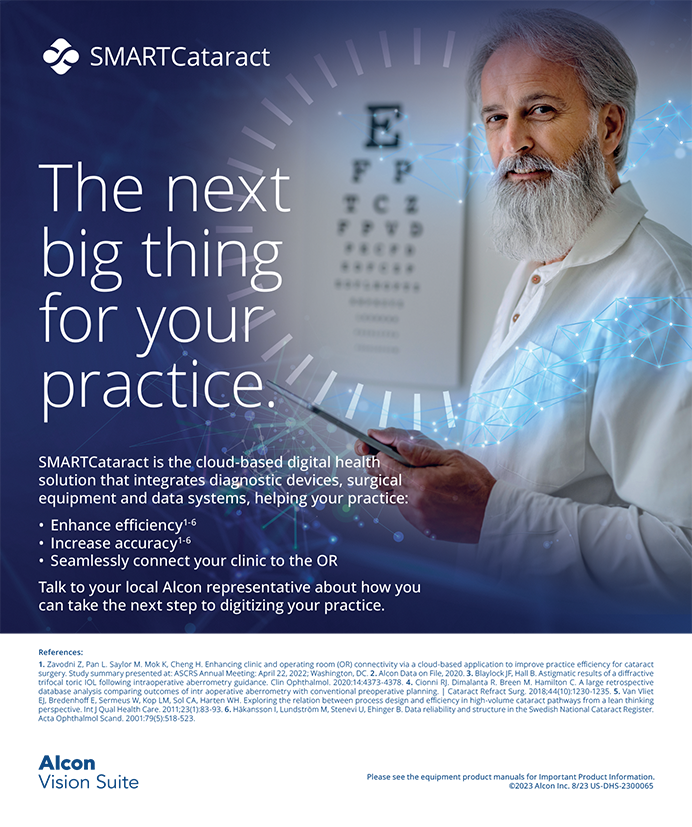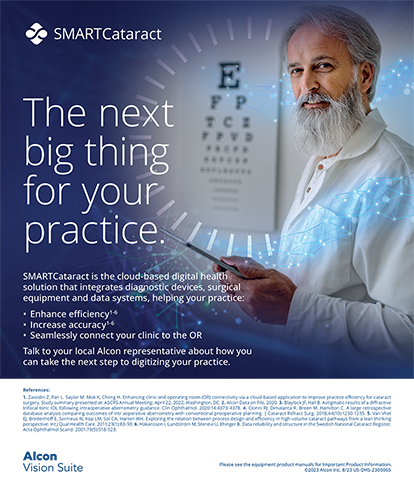In cases of irregular astigmatism (eg, after radial keratotomy [RK], after penetrating keratoplasty, “stable” corneal ectasias), what are your guidelines for considering the use of a toric IOL? Is your approach different if the patient is a long-term wearer of rigid gas permeable (RGP) contact lenses?
—Topic prepared by Steven Dewey, MD.
ROBERT J. CIONNI, MD
Patients with irregular astigmatism are no different than other patients in that they often desire the best vision possible without having to rely on glasses or contact lenses. Many of the former previously paid for RK to achieve good UCVA. Providing these patients with the spectacle freedom they desire, however, can be quite challenging. A few pearls can improve the chances of meeting their expectations.
Most patients with irregular astigmatism have significant higher-order aberrations. Unless they have been successful with monovision, I explain that they will likely need reading glasses after surgery, because I am very hesitant to offer a multifocal IOL to any patient with more than 0.30 D of coma or trefoil. In general, the conversation revolves around the management of their astigmatism.
If the patient’s old glasses, refraction, and keratometry (K) values as measured by an autokeratometer, Atlas 9000 Corneal Topography System (Carl Zeiss Meditec), and Lenstar LS900 (Haag-Streit) all line up fairly well, I am quite confident that a toric IOL will significantly reduce his or her astigmatism. I find that this impression is typically confirmed by intraoperative aberrometry (ORA System; WaveTec Vision).
If there are significant discrepancies between the preoperative K values and the patient’s old glasses or refraction, I rely heavily on intraoperative aberrometry, which has markedly improved my results. Interestingly, in such cases, I find that measurements with the ORA System usually correlate better with the old glasses than with the preoperative K values. Because not even intraoperative aberrometry is foolproof, it is important to explain to the patient at the preoperative visit that a postoperative enhancement (piggyback IOL, PRK, IOL rotation or exchange) may be needed to achieve his or her best UCVA.
Before proceeding with surgery, patients who are long-term wearers of RGP contact lenses would need to discontinue their use until the refraction stabilized. I caution such individuals that their postoperative visual outcome might not be as crisp as what they enjoyed before developing a cataract, because RGP lenses reduce corneal aberration. If they were comfortable with an RGP lens solution after cataract surgery, then I would not implant a toric IOL.
D. REX HAMILTON, MD
A cataract patient with irregular astigmatism poses a significant challenge to the operating surgeon. He or she must consider the etiology of the irregular astigmatism when deciding the optimal treatment strategy.
Corneal surface diseases can lead to erroneous astigmatic measurements using all devices and methods, including the IOLMaster (Carl Zeiss Meditec), Lenstar LS900, topographers, and manual keratometry. Severe dry eye disease, Salzmann nodular degeneration, and anterior basement membrane dystrophy are notorious sources of irregular astigmatism. The use of more than one imaging modality is critical to identifying inconsistent measurements, which, if present, should contraindicate the immediate use of a toric IOL. Each of these etiologies should be treated (cyclosporine ophthalmic emulsion 0.05% [Restasis; Allergan]/medical management, superficial keratectomy, epithelial debridement with diamond burr polish) and the eye allowed to heal. Afterward, I would want to see two stable topographies separated by at least 3 weeks before embarking on cataract surgery with astigmatic management (eg, toric IOL or treatment with astigmatic keratotomy/limbal relaxing incisions).
I handle irregular astigmatism associated with keratoconus and previous refractive surgery a bit differently. In a patient with relatively mild cataracts, the manifest refraction magnitude and axis can help to confirm whether or not the corneal astigmatism is regular enough to be neutralized by a toric IOL. If the manifest axis and magnitude match the corneal axis and magnitude fairly well, I consider implanting a toric IOL. This type of lens is especially valuable in patients with keratoconus, whose other options for astigmatic treatment are limited. The post-RK patient is a separate entity, and a toric IOL should be used with extreme caution. Particularly in eyes with eight or more radial incisions, the astigmatism induced by a clear corneal incision can be much greater and more variable than it would be for a virgin cornea. I prefer to place a nontoric aspheric monofocal lens, permit the refraction to stabilize, and perform PRK to optimize the patient’s unaided acuity.
For patients with advanced cataracts, the surgeon must rely on topography to guide the use of a toric IOL. A decentered apex, skewing of the radial axis, and significant superior/inferior astigmatic asymmetry deter me from selecting a toric IOL. For a patient with a history of penetrating keratoplasty, a toric IOL is an option if he or she is unlikely to require a repeat corneal transplant and if the astigmatism is regular, as discussed earlier.
KARL G. STONECIPHER, MD
I will start with the second question posed by Dr. Dewey, because it deals with the preoperative consultation, which determines success or failure in this patient population. I always begin by asking patients with irregular astigmatism two questions:
-
When we are done with cataract surgery, would you like to be without glasses or contact lenses?
-
Are you willing to pay extra for less spectacle dependence?
If they answer no to either question, a toric IOL is not an option. If they answer yes to both questions, I pose a third: “You know that you have challenging anatomy. If we do not hit the mark and you are unhappy with your vision postoperatively, are you willing to pay extra for additional laser vision correction if indicated and if it is an option or to resume wearing glasses or contact lenses?
By asking these three questions, I am exploring the patient’s mindset. Just as I do prior to refractive laser vision correction, I instruct patients with irregular astigmatism to stop wearing their RGP contact lenses. Instead, either they can wear glasses (which will not correct their vision like the contact lenses did), or they can use soft contact lenses without astigmatic correction and piggyback the residual refractive error in glasses. In addition, I inform patients that it will take 1 month per decade of RGP wear before we will probably see refractive stability.
Irregular astigmatism comes in a variety of forms. According to a recent study by Trattler et al,1 roughly 81% of normal patients (ie, no preoperative pathology) presenting for cataract surgery will have ocular surface disease (OSD) at Dry Eye Disease International Task Force level 2 or higher. For this reason, I aggressively treat OSD and monitor patients’ manifest refraction, computed topography, computed tomography, and biometry over the course of refractive stabilization. Potvin and Hill showed how to better predict IOL power selection based on computed tomography using the equivalent K-reading value at the 4-mm optical zone for keratography readings with the Pentacam Comprehensive Eye Scanner (Oculus Optikgeräte) associated with biometry.2 Both the Lenstar LS900 and the IOLMaster have software to evaluate the precision of measured corneal curvature and to warn doctors when issues exist. It is important to heed these warnings. Obviously, IOL power calculations are based on the formulas that exist for postrefractive surgery or complicated anatomy, and that is another discussion entirely.
Once I have aggressively treated OSD and refractive stability has been achieved, can I define an axis of astigmatism? If not, then I will let patients know that their best option is a spherical rather than a toric lens. I find it better to let them down easy before surgery than afterward. Postoperatively, patients will perceive the problem to be mine, not theirs, which is a bad position for a surgeon to be in with any patient.
If I can define an axis and a toric lens has been selected, prior to surgery, I will use the RoboMarker (Surgilum) to mark the cornea. Other options include Toreasy (toreasy.com) and the Steinert/Oliver Smart Phone Marker (Rhein Medical). I will use intraoperative aberrometry or WaveTec analysis to help align the lens. In many of these cases, however, I am unable to obtain a measurement, or the measurement contradicts my preoperative planning. For this reason, I take the time to accurately mark these eyes prior to the surgery. I can always implant a spherical lens if issues arise during surgery, and I discuss this possibility with patients preoperatively.
Postoperatively, I emphasize to patients that it will take time for their vision to stabilize. I remind them at the first postoperative visit that they may need additional surgery, glasses, or contact lenses in the future. I also encourage them not to compare their results to those of other cataract surgery patients; the postoperative courses will be different, and I do not want them to feel discouraged. If I have adequately prepared the patient preoperatively, such discussions are much easier on both of us.
Section Editor Alan N. Carlson, MD, is a professor of ophthalmology and chief, corneal and refractive surgery, at Duke Eye Center in Durham, North Carolina.
Section Editor Steven Dewey, MD, is in private practice with Colorado Springs Health Partners in Colorado Springs, Colorado. Dr. Dewey may be reached at (719) 475-7700; sdewey@cshp.net.
Section Editor R. Bruce Wallace III, MD, is the medical director of Wallace Eye Surgery in Alexandria, Louisiana. Dr. Wallace is also a clinical professor of ophthalmology at the Louisiana State University School of Medicine and an assistant clinical professor of ophthalmology at the Tulane School of Medicine, both located in New Orleans.
Robert J. Cionni, MD, is the medical director of The Eye Institute of Utah and an adjunct clinical professor at the Moran Eye Center of the University of Utah in Salt Lake City. He is a consultant to WaveTec Vision. Dr. Cionni may be reached at (801) 266-2283.
Karl G. Stonecipher, MD, is the director of refractive surgery at TLC in Greensboro, North Carolina. He acknowledged no financial interest in the products or companies he mentioned. Dr. Stonecipher may be reached at (336) 288- 8523; stonenc@aol.com.
- Trattler WB. Cataract and dry eye: Prospective Health Assessment of Cataract Patients Ocular Surface study. Paper presented at: ASCRS Symposium on Cataract, IOL and Refractive Surgery; March 25-29, 2011; San Diego, CA.
- Potvin R, Hill W. New algorithm for post-radial keratotomy intraocular lens power calculations based on rotating Scheimpflug camera data. J Cataract Refract Surg. 2013;39(3):358-365.


